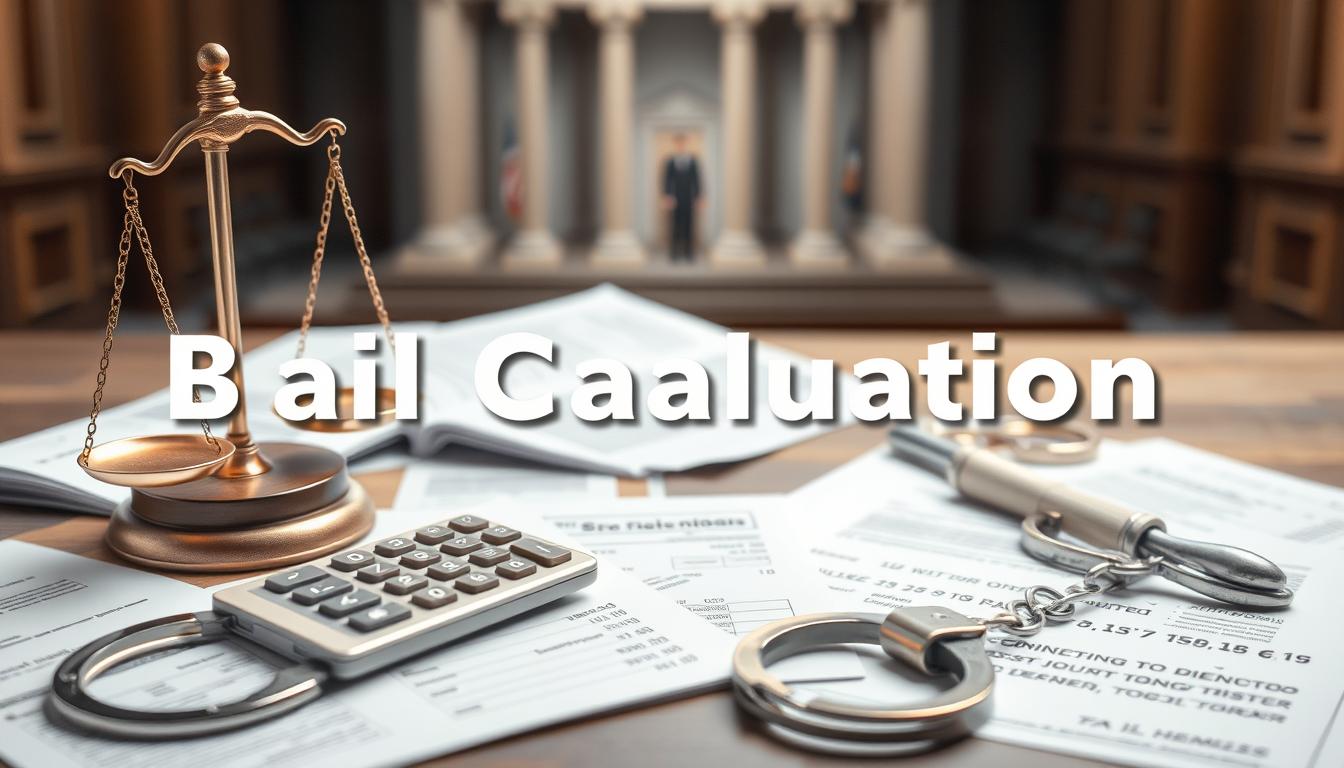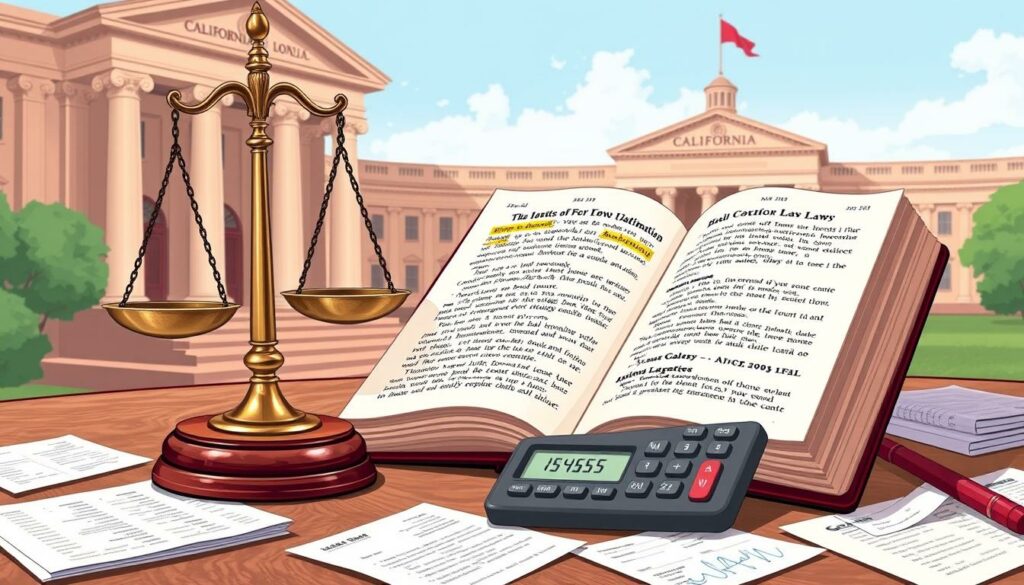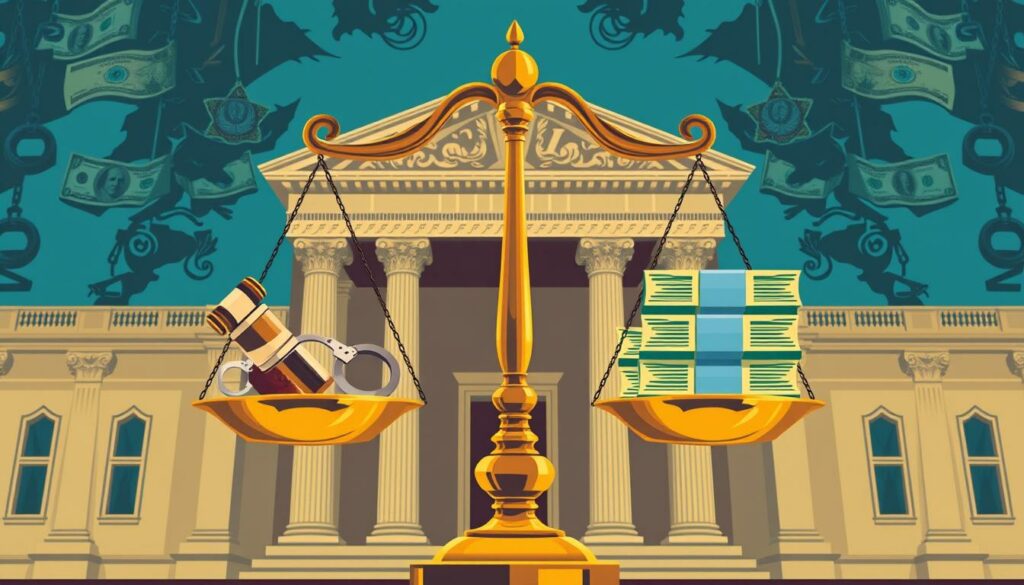
27 Jan How Is Bail Calculated?
Bail is key in the criminal justice system. It lets defendants get out of jail while they wait for their trial. Knowing how bail is calculated is vital for those going through the pretrial release process. The bail amount can change a lot, based on different factors and local rules.
In the U.S., most states start with a bail schedule to figure out bail amounts. These schedules can change from county to county. They reflect local crime rates and what the courts focus on. The bail amount looks at the crime’s severity, the defendant’s past crimes, and how likely they are to run away.
Bail bonds act as a financial promise that the accused will show up for court. Many can’t afford to pay bail directly. So, they turn to bail bond services. These services charge a part of the bail amount as their fee.
Key Takeaways
- Bail amounts are based on state and county-specific schedules
- The severity of the crime impacts bail calculation
- A defendant’s criminal history is considered when setting bail
- Flight risk assessment influences bail amounts
- Bail bonds offer an alternative for those unable to pay full bail
- Judges have discretion to adjust bail based on individual circumstances
Understanding the Basics of Bail in the Criminal Justice System
The bail system is key in the American criminal justice process. It helps ensure defendants show up for court while they’re free before trial. Let’s look at the main points of bail and why it matters in legal cases.
Definition and Purpose of Bail
Bail is a financial promise made by a defendant to get out of jail. Its main goal is to make sure the accused comes back to court. This system balances the rights of the accused with public safety and justice.
Role of Bail in Pretrial Release
The bail process is vital in pretrial steps. At a bail hearing, a judge looks at different things to decide on bail. These include the crime, the defendant’s past, and their community ties. The goal is to make bail fair and consistent.
Constitutional Rights and Bail
The U.S. Constitution protects against unfair bail through the Eighth Amendment. This right makes sure bail isn’t used to punish but to ensure court appearance. Bail hearings must follow these rules, balancing safety with the right to be innocent until proven guilty.
| Bail Aspect | Description |
|---|---|
| Purpose | Ensure court appearance |
| Constitutional Protection | 8th Amendment |
| Key Consideration | Flight risk |
Understanding bail basics is key to getting through the criminal justice system. As we explore how bail is calculated, remember these principles. They help make sense of bail decisions.
How Is Bail Calculated in California Courts
Bail in California is structured to ensure defendants show up for court. The amount is determined through a series of steps. These steps are unique to California’s legal system.
After an arrest, the person is booked into custody. Law enforcement then checks the county’s bail schedule. This schedule lists bail amounts for common crimes, starting the bail process in California.

Judges use these schedules but can adjust the bail. They look at several factors, including:
- Severity of the alleged crime
- Defendant’s criminal history
- Flight risk
- Community ties
- Public safety concerns
California has recently changed how bail is set. Some areas now use risk assessment tools. These tools help decide if a defendant can be safely released without bail.
| Offense | Typical Bail Range |
|---|---|
| Misdemeanor DUI | $5,000 – $15,000 |
| Felony Burglary | $20,000 – $50,000 |
| Assault with a Deadly Weapon | $30,000 – $100,000 |
It’s important to understand how bail is set in California courts. This knowledge helps defendants and their families. It ensures public safety while respecting the right to reasonable bail, shaping the state’s justice system.
The Uniform Bail Schedule and County Variations
California counties follow Uniform Bail Schedules for bail decisions. These schedules list bail amounts for different crimes. This helps judges set fair bail. The Wisconsin Legislative Council’s review shows similar practices in other states.
County-Specific Bail Schedules
Each California county has its own bail schedule. This means bail for the same crime can vary. For example, a DUI might cost $5,000 in one county but $10,000 in another.
Standard Bail Amounts for Common Offenses
Bail schedules give standard amounts for common crimes. Here are some examples:
| Offense | Typical Bail Amount |
|---|---|
| Petty Theft | $1,000 – $5,000 |
| Assault | $10,000 – $25,000 |
| Drug Possession | $5,000 – $20,000 |
Annual Updates to Bail Schedules
Counties update their bail schedules every year. This keeps bail amounts current with laws and community needs. Judges, prosecutors, and defense attorneys help with these updates. They aim to balance public safety with fair treatment of defendants.
Key Factors Influencing Bail Amount Determination
When courts set bail, they look at several bail amount factors. These help judges decide on fair pretrial release conditions.
Severity of the Alleged Crime
The type of crime is a big factor in bail decisions. Serious crimes usually mean higher bail. For instance, violent felonies have steeper bail than misdemeanors.
Prior Criminal History
A person’s past crimes affect bail. Those with no record might get lower bail. But, repeat offenders or those who’ve skipped court before could face higher amounts.
Flight Risk Assessment
Courts check how likely someone is to flee before trial. They look at community ties, job status, and family connections. Strong local roots can mean lower bail or even no bail.
Community Ties and Stability
Having stable housing, a steady job, and family support matters. These show a person is less likely to flee and more likely to return to court.
| Factor | Impact on Bail |
|---|---|
| Serious Crime | Higher bail |
| Clean Record | Lower bail |
| High Flight Risk | Higher bail |
| Strong Community Ties | Lower bail |
The Role of Judicial Discretion in Setting Bail

Judges play a big role in setting bail. They make decisions based on each case’s unique facts. This lets them adjust bail amounts when needed.
When deciding on bail, judges look at several things:
- Severity of the alleged crime
- Defendant’s criminal history
- Community ties
- Flight risk
- Public safety concerns
These factors help judges balance public safety and the defendant’s right to be presumed innocent. Judicial discretion in bail decisions can result in different bail amounts for similar crimes. This shows how complex the process is.
Judges have a lot of freedom in setting bail, but they must follow the law. The Constitution limits bail to ensure it’s fair. This keeps bail amounts in line with the crime.
The role of judicial discretion in bail highlights the need for fairness and legal help. Defendants need good lawyers to fight for better bail conditions or other release options.
Bail Calculation Methods for Different Crime Categories
In California, bail calculation methods change with the crime type. Knowing these differences is key for those in the legal system.
Felony Offense Bail Calculations
Felony crimes usually have higher bail because they are more serious. For felonies not listed, bail is often $10,000. Serious felonies can have bail in the hundreds of thousands.

Misdemeanor Offense Bail Amounts
Misdemeanors have lower bail than felonies. Bail for unlisted misdemeanors is usually $2,500. This shows the law sees these crimes as less serious.
Special Circumstances and Enhancements
Some factors can greatly increase bail. These include using a weapon or having past crimes. “Wobbler” crimes, which can be felonies or misdemeanors, often have bail at half the felony amount.
| Crime Category | Standard Bail Amount | Special Circumstances |
|---|---|---|
| Unlisted Felony | $10,000 | Can increase with aggravating factors |
| Unlisted Misdemeanor | $2,500 | May be higher for repeat offenders |
| Wobbler Offense | 50% of felony amount | Depends on charging decision |
These bail amounts are guidelines in California. Judges can adjust them based on the case. This ensures fairness between public safety and the accused’s rights.
Alternative Release Options and Bail Reform
The criminal justice system is changing. New ways to release people before trial are becoming popular. These changes aim to make the system fairer while keeping everyone safe.
Own Recognizance Release
Some defendants can be released without bail. They promise to show up in court. Judges look at community ties and past crimes to decide.
Pretrial Services Programs
Pretrial services are an alternative to bail bonds. They check if a defendant is a risk. They also supervise them to make sure they show up in court.
Recent Bail Reform Initiatives
Bail reform is changing how people are released before trial. In 2018, California made a big change by ending cash bail. This gave judges more freedom to decide who stays in jail.
But, the reform faced legal issues. Supporters say it’s fairer. Critics worry about safety. Many states are trying to find a balance between justice and safety.
The Bail Bond Process and Payment Options
Bail bonds are key in California’s bail system. They help when someone can’t pay the full bail. Bail bondsmen post a bond for the court, allowing release from jail.
To get a bail bond, you pay a percentage of the bail, often 10%. For instance, if bail is $50,000, you pay $5,000 to the bondsman. The bondsman then covers the full amount to the court.
There are different ways to pay for bail:
- Cash bail: Pay the full amount to the court
- Property bonds: Use real estate as collateral
- Surety bonds: Work with a bail bond company
Each method has its own advantages and disadvantages. Cash bail is refundable but requires a big upfront payment. Property bonds risk losing your home if you miss court. Surety bonds are cheaper but have non-refundable fees.
It’s vital to understand these options when dealing with bail in California. Think carefully about each choice before deciding on pretrial release.
Special Considerations in Bail Calculations
Bail calculations can be complex, with many factors to consider. Courts aim to balance public safety with defendants’ rights. Let’s look at some special considerations that affect bail decisions.
Multiple Offense Scenarios
For defendants with multiple charges, courts focus on the most serious offense. They consider all charges together, which can raise the bail amount. This ensures the defendant is held accountable for their actions.
Prior Bail Violations
Defendants with a history of bail violations face stricter bail conditions. Judges may set higher bail or deny release if a defendant has skipped court before. This is to ensure they show up for their court dates.
Public Safety Concerns
Public safety is key in bail decisions. Violent crimes or repeat offenses lead to higher bail. If a crime was committed while on bail, the bail might double. This is to protect the community.
| Scenario | Impact on Bail |
|---|---|
| Multiple offenses | Bail set at highest amount for most serious charge |
| Prior bail violations | Higher bail or possible denial of release |
| Crime committed while on bail | Bail amount may be doubled |
These special considerations help courts make fair bail decisions. They balance defendant rights with community safety. Understanding these factors sheds light on the bail system’s complexities.
Conclusion
The bail process in the criminal justice system is complex. It balances set bail amounts with the judge’s decision. In California, bail varies by county, considering the crime’s severity, past crimes, and flight risk.
Bail reform is a hot topic, with new ways to release people without bail. This includes letting them go on their own word and using pretrial services. The bail bond process offers a way for those who can’t afford bail to get out.
It’s key to understand how bail is set. This knowledge helps defendants, their families, and the public. Knowing about bail policies in your area is important. It affects people and communities in the criminal justice system. The changing bail practices show the need to protect everyone’s rights and safety.

